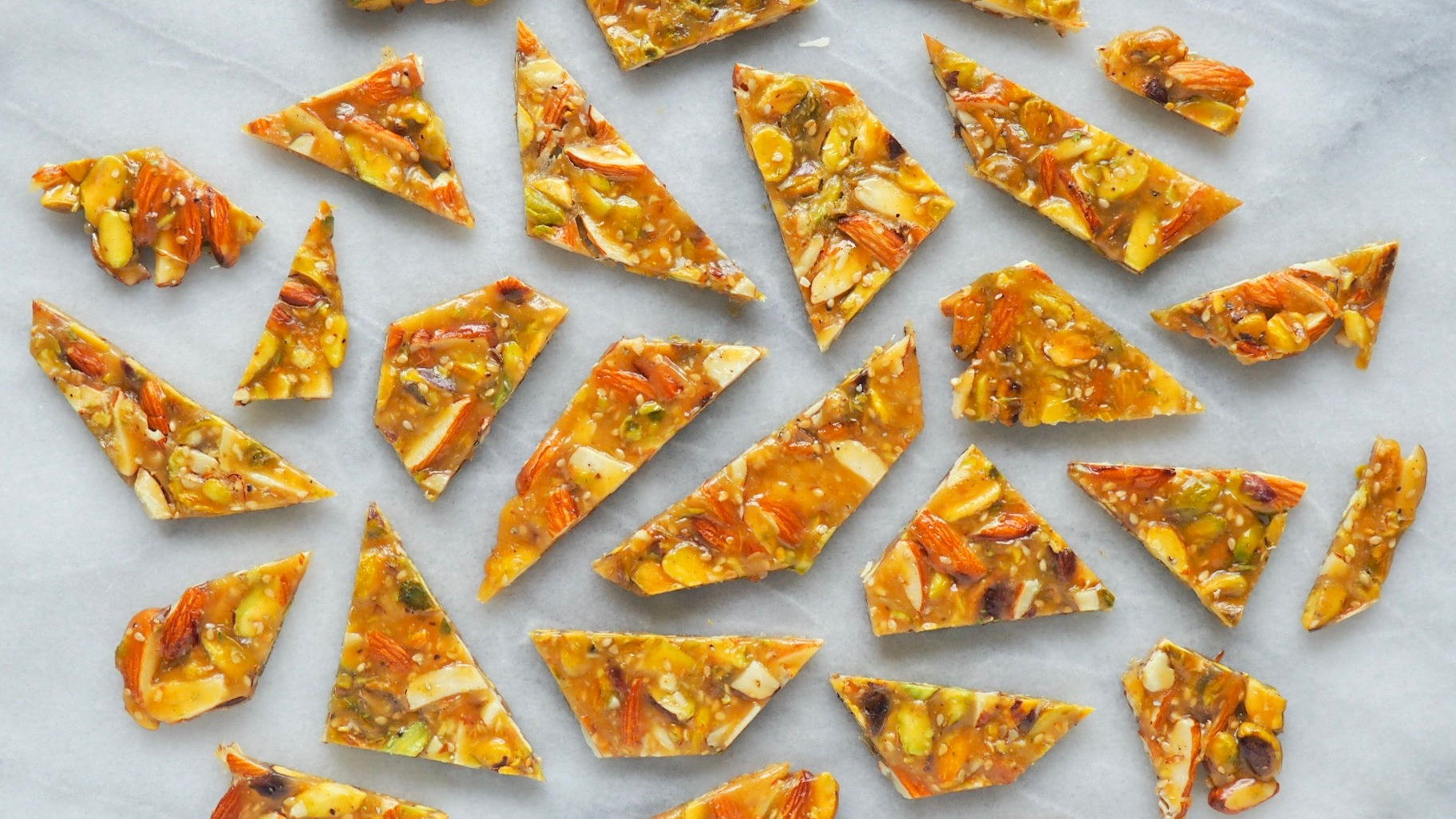This Easy South Asian Brittle Needs No Thermometer, Just TLC
We may receive a commission on purchases made from links.
Brittle, often made with ghee and jaggery, is a common sweet treat across South Asia, and varieties are named after the ingredients used, from sesame seeds and puffed rice to nuts and desiccated coconut. My favorite brittle, varo (pronounced vuh-ROH), originates in Sindh, Pakistan's southwest province, to where my paternal and maternal families trace their roots. Varo was a fixture of my childhood, a perfect comfort food, and both my late grandmothers touted its warming properties, as well as its nutritive ones: the nuts are full of protein! The jaggery is full of iron! My family calls this "dry fruit varo," despite there being no trace of fruit in it. I don't know when or how the alternate name originated, but it stuck.
Sindhi cuisine is lesser known both on the Subcontinent and throughout the diaspora. In an informative piece for Dawn (one in which, full disclosure, I am quoted), Maryam Jillani writes that this sub-cuisine straddles two countries, yet identifies with neither. "While Sindhi food, influenced by Central Asian culinary traditions, certainly has strains of Mughal cuisine, it is distinctive enough that... Sindhis find that the food they have at home is not necessarily what their friends eat," she says. "Despite the rich and accessible flavours of Sindhi food, it has not found its way to Pakistani or Indian mainstream cuisine."
The Sindhi recipes in my repertoire are not from cookbooks. Indeed, there are few cookbooks devoted to Sindhi cuisine, and while there are a handful of community cookbooks, those have their limitations. My recipes come from observing my grandmothers and aunts and aunties, then drawing from both the sensory and muscle memory of how to make the dish as I test in the kitchen. For the past decade or so, I've been keeping extensive notes, because I'm the family scribe.
I collated this particular recipe last fall from a series of WhatsApp messages, the preferred mode of communication among those of us with far-flung family members, sent by my maternal aunt. Her recipe includes references to katoris (small stainless-steel serving bowls) as units of measurement, and she suggests rolling out the brittle with a belan chakla, a thin, cylindrical wooden rolling pin and flat circular rolling board. I quickly understood that ratios of ingredients, rather than precise quantities, were key to adapting this recipe for my modern American kitchen and my assimilated ways. The sugar-to-nut ratio is always 1:1, and "the katoris can be level or heaped," my aunt WhatsApped.
Also, like the many home cooks who came before me, I don't fuss with a candy thermometer when making varo (although I've included precise temperatures in the recipe below, should you prefer them). I learned how to estimate the temperature of boiling sugar in my grandmothers' spare railroad kitchens: sugar has reached the "hard crack" stage when a drop of the caramel in ice cold water hardens into a crunchy toffee. Varo is a very forgiving treat. Several times, I've not landed precisely on the small temperature window needed for hard-crack candy. The color is the candy's tell: when the sugar has turned amber, I know the varo will be crunchy and brittle-like.
In this take on varo, I added saffron, which is a deviation from the family recipe. I was also first inclined to drizzle these with dark chocolate, but ultimately decided not to futz with a classic. The result is a complex, jewel-like treat that shatters between your teeth and melts in your mouth.
As with any brittle, shards of varo can be eaten on their own, as candy, or used to decorate cakes or tarts; crushed varo can be sprinkled over ice cream or stirred into yogurt.
Sindhi Varo
Note: Varo is made with ghee (clarified butter) and jaggery (unrefined cane sugar), but you can substitute the ghee with unsalted butter and the jaggery with granulated sugar. (Brown sugar preferred, but white is fine if that's all you have.) Refined sugar doesn't have jaggery's earthy and spicy notes, but the cooking chemistry remains the same, and the final product will still be delicious, I promise! Also, it's crucial to have your ingredients ready before starting; varo comes together fairly quickly, and the sugar can burn if you don't watch it carefully.
- 100 g (¾ cup) slivered nuts (a mix of almonds, pistachios, or cashews)
- 100 g (½ cup) jaggery or white or brown granulated sugar
- 56 g (4 Tbsp.) ghee or unsalted butter
- 1 tsp. cardamom powder
- 2 tsp. white poppy seeds
- Pinch of saffron (optional)
- ½ tsp. sea salt
Prepare a work surface by greasing liberally with ghee or butter; grease a rolling pin as well.
In a heavy-bottomed pot over low heat, bring ghee and jaggery to a low boil. Stir constantly.
If using a thermometer: When the sugar mixture is just shy of 300F, add salt, cardamom, poppy seeds, and saffron. Keep stirring! Once the sugar mixture has reached 300F, remove from flame and add the nuts. Work quickly and make sure that all the nuts are coated with sugar mixture.
If not using a thermometer: When the sugar has turned amber and a drop of the caramel in ice cold water hardens into a crunchy toffee, add salt, cardamom, poppy seeds, and saffron. While still stirring, remove from flame and add the nuts. Work quickly and make sure that all the nuts are coated with sugar mixture.
Pour onto the greased surface, and roll as thinly as possible, into an 8" by 8" slab. (Again, work quickly.) Allow to set, 30 to 45 minutes, and break or cut into bite-sized pieces.
